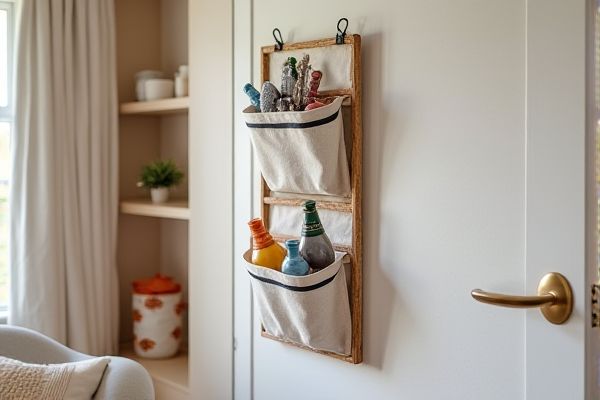
Door organizers maximize vertical space by hanging over the door, perfect for small rooms where floor space is limited, while wall organizers attach directly to walls, offering customizable storage options and easy access. Discover which organizer suits your needs best and how to optimize your space by reading the rest of the article.
Table of Comparison
| Feature | Door Organizer | Wall Organizer |
|---|---|---|
| Installation | Hangs over door, no tools needed | Mounted on wall, requires screws or adhesives |
| Space Saving | Utilizes door space, ideal for rooms with limited floor space | Maximizes vertical wall space, good for open areas |
| Capacity | Typically medium capacity, limited by door size | Varies, can be customized with multiple shelves or hooks |
| Accessibility | Accessible when door is open | Always accessible, fixed location |
| Customization | Limited customization options | Highly customizable in design and layout |
| Best Use | Small items like shoes, accessories, cleaning supplies | Organizing tools, stationery, kitchen items, or decorations |
| Price Range | Affordable, typically $10-$30 | Varies widely, $20-$100+ |
Introduction: Door Organizer vs Wall Organizer
Door organizers maximize storage by utilizing the back of doors, perfect for small spaces or areas with limited wall access. Wall organizers offer versatile options for hanging items at eye level, providing easy access and visibility in kitchens, offices, or workshops. Choosing between a door or wall organizer depends on your available space and storage needs, ensuring efficient organization tailored to your lifestyle.
Space Optimization: Comparing Effectiveness
Door organizers maximize vertical space by using the often-overlooked area behind doors, making them ideal for small rooms or closets with limited floor space. Wall organizers offer greater flexibility by covering larger surfaces and supporting heavier items, optimizing space in kitchens, offices, or garages. Both solutions enhance organization, but door organizers excel in tight spaces, while wall organizers provide broader storage capacity.
Installation and Setup Differences
Door organizers typically require minimal installation, often utilizing hooks or tension rods that fit over the door without drilling, making setup quick and damage-free. Wall organizers, on the other hand, generally need more permanent installation methods such as screws, nails, or adhesive strips, which can involve tools and potential wall damage. This distinction affects flexibility and relocation options, with door organizers offering easier repositioning compared to fixed wall-mounted systems.
Accessibility and Convenience
Door organizers maximize accessibility by utilizing vertical space behind doors, keeping items within easy reach without cluttering living areas. Wall organizers offer customizable storage solutions that can be mounted at eye level, enhancing convenience for frequently used items. Your choice depends on the specific space available and how quickly you need access to your belongings.
Versatility and Usage Scenarios
Door organizers maximize space by utilizing the back of doors, making them ideal for kitchens, bathrooms, and closets with limited floor space. Wall organizers offer greater customization and visibility, suitable for home offices, garages, and craft rooms where easy access and organization of tools or supplies is essential. Both options enhance organization, but door organizers excel in compact areas, while wall organizers provide flexible storage across larger, more open spaces.
Aesthetic Considerations
Door organizers maximize vertical storage without consuming floor space, offering a sleek and functional aesthetic ideal for small rooms, while wall organizers provide more customizable and visible storage options that can be tailored to complement your room's decor. Your choice depends on whether you prioritize discreet storage with a minimalist look or want to enhance the visual appeal by displaying items as part of your interior design. Both options help maintain a tidy environment but differ in how they contribute to the overall aesthetics of your living space.
Durability and Material Quality
Door organizers often feature sturdy materials like heavy-duty fabric or reinforced plastic designed to withstand frequent handling and weight, making them highly durable for everyday use. Wall organizers typically utilize materials such as metal, wood, or high-quality MDF, offering robust structural integrity and long-lasting performance when securely mounted. Material quality in both options directly impacts longevity, with metal and hardwood wall organizers generally providing greater durability compared to fabric door organizers.
Cost Comparison
Door organizers typically cost less due to simpler installation and smaller size, making them a budget-friendly choice for maximizing space. Wall organizers may involve higher expenses because of sturdier materials, larger designs, and professional mounting requirements. Your decision should balance cost with the desired storage capacity and installation ease.
Maintenance and Cleaning
Door organizers typically require less frequent cleaning due to their enclosed spaces, making maintenance easier and protecting items from dust accumulation. Wall organizers, often exposed and open, demand regular wiping to prevent dust and dirt buildup, especially on shelves and hooks. Your choice depends on how much time you want to dedicate to upkeep and the level of accessibility you need for quick cleaning.
Choosing the Right Organizer for Your Needs
Door organizers maximize unused space by hanging on the back of doors, offering easy access to items like shoes, accessories, or cleaning supplies. Wall organizers provide versatile storage options by utilizing vertical space on any wall, ideal for holding tools, office supplies, or kitchen utensils while keeping your surfaces clear. Your choice depends on available space, the type of items to store, and how frequently you need to access them.
 homyna.com
homyna.com